Summer is a peak season for agricultural activities, and ensuring your tractor is in optimal condition is crucial for uninterrupted operations. Regular maintenance not only extends the lifespan of your equipment but also enhances safety and efficiency. Here are five essential summer maintenance tips to keep your tractor performing at its best:
1. Inspect and Clean the Battery
High temperatures can accelerate battery corrosion and reduce its efficiency. Begin by checking the battery terminals for any signs of corrosion or buildup. Clean the terminals and ensure all connections are tight. If your tractor has been idle, test the battery’s charge and recharge or replace it if necessary. A well-maintained battery ensures reliable starts and prevents unexpected downtimes.
2. Replace Old Fuel with Fresh Supply
Fuel left in the tank from previous seasons can degrade over time, leading to condensation buildup and potential engine issues. Drain any old fuel and refill the tank with a fresh supply. This practice prevents moisture-related problems and ensures smooth engine performance during the demanding summer months.
3. Check and Top Off All Fluid Levels
Fluids play a vital role in your tractor’s operation, especially under the stress of summer heat. Inspect and top off essential fluids, including:
-
Engine Oil: Ensures proper lubrication and reduces friction.
-
Coolant: Prevents the engine from overheating.
-
Hydraulic Fluid: Maintains the efficiency of hydraulic systems.
-
Transmission Fluid: Ensures smooth gear shifts and operation.
Regularly monitoring and maintaining these fluids can prevent costly repairs and extend your tractor’s lifespan.
4. Inspect Tires and Adjust Pressure
Tire condition directly affects your tractor’s performance and fuel efficiency. Examine tires for signs of wear, cracks, or punctures. Ensure that the tire pressure aligns with the manufacturer’s recommendations, adjusting as necessary for the specific tasks and loads. Properly maintained tires enhance traction and reduce soil compaction.
Recommended Tractor Tire Pressures
Here’s a reference table for common tractor tire sizes and their recommended PSI:
| Tire Size | Load Index | Recommended PSI |
|---|---|---|
| 14.9-24 | 126 | 20 |
| 16.9-28 | 134 | 22 |
| 18.4-30 | 142 | 24 |
| 20.8-38 | 155 | 26 |
| 23.1-26 | 160 | 28 |
| 24.5-32 | 170 | 30 |
| 30.5-32 | 176 | 32 |
| 320/85R24 | 122 | 23 |
| 340/85R28 | 127 | 25 |
| 380/85R28 | 133 | 27 |
| 420/85R30 | 140 | 29 |
| 460/85R38 | 147 | 31 |
| 520/85R42 | 157 | 33 |
| 580/70R38 | 160 | 35 |
| 620/75R26 | 166 | 38 |
| 710/70R42 | 173 | 40 |
Note: Always consult your tractor’s manual or tire manufacturer’s guidelines for precise pressure settings based on load and operating conditions.
5. Clean or Replace Air Filters
Dust and debris are more prevalent during summer, making air filters susceptible to clogging. A dirty air filter can restrict airflow, reducing engine efficiency and increasing fuel consumption. Inspect the air filter regularly, cleaning or replacing it as needed to maintain optimal engine performance.

